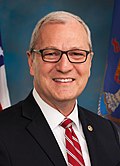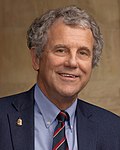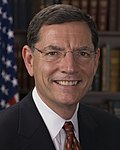Top Qs
Timeline
Chat
Perspective
2024 United States Senate elections
Senate election for the 119th US Congress From Wikipedia, the free encyclopedia
Remove ads
The 2024 United States Senate elections were held on November 5, 2024. Regularly scheduled elections were held for 33 out of the 100 seats in the U.S. Senate,[4][5] and special elections were held in California[6] and Nebraska.[7] U.S. senators are divided into three classes whose six-year terms are staggered so that a different class is elected every two years.[8] Class 1 senators faced election in 2024.[9] Republicans flipped four Democratic-held seats, regaining a Senate majority for the first time in four years, and the most gains for either party since 2014. Republicans successfully defended all of their own seats for the first time since 2014. This was the first time since 1980 that Republicans flipped control of a chamber of Congress in a presidential year.[10]
A total of 25 U.S. senators (14 Democrats, nine Republicans, and two independents) sought re-election in 2024,[11] while seven senators declined to seek re-election.[12] In addition, Democrats Sen. Laphonza Butler of California[13] and Sen. George Helmy of New Jersey[14] – each of whom had been appointed to their respective Senate seats – did not seek election in 2024. Concurrent with the 2024 regular Senate elections, two special Senate elections took place: one in California, to fill the final two months of Dianne Feinstein's term following her death in September 2023; and one in Nebraska, to fill the remaining two years of Ben Sasse's term following his resignation in January 2023.[15][16][17]
Republicans won control of the U.S. Senate by flipping an open independent-held seat in West Virginia; defeating Democratic incumbents in Montana, Ohio, and Pennsylvania; and retaining all the seats they had previously held. Democrats flipped a seat in Arizona from an Independent who caucused with the Democrats. Democratic candidates were elected in Arizona, Michigan, Nevada, and Wisconsin, despite Trump having won those states. No Republican won in a state that Kamala Harris carried in the presidential election.
Remove ads
Partisan composition
Summarize
Perspective
All 33 Class 1 Senate seats, and one Class 2 seat, were up for election in 2024; Class 1 currently consisted of 20 Democrats, four independents who caucus with the Senate Democrats,[d] and 10 Republicans.
Burgess Everett of Politico considered the map for these Senate elections to be highly unfavorable to Democrats. Democrats were to defend 23 of the 33 Class 1 seats,[20] including three in states won by Republican Donald Trump in both 2016 and 2020. In contrast, there are no seats in this class held by Republicans in states won by Democrat Joe Biden in 2020. In the previous Senate election cycle that coincided with a presidential election (2020), only one senator (Susan Collins of Maine) was elected in a state that was simultaneously won by the presidential nominee of the opposite party.[21]
Republican gains were attributed to better candidate quality compared to 2022[22] and to the coattails of Republican presidential candidate Donald Trump, who won the 2024 presidential election.[23] Time's Eric Cortellessa wrote that the thesis of the Republicans' success boiled down to the simple slogan "Max out the men and hold the women", meaning emphasizing the economy and immigration, which Trump did "relentlessly". Cortellessa also mentioned Trump's minimization of his numerous controversies, and push-offs of criminal trials via "a combination of friendly judges and legal postponements" to after the election. He said Trump's "advanced age and increasingly incoherent trail rhetoric" were taken by voters in stride, and that "much of the country read Trump's legal woes as part of a larger corrupt conspiracy to deny him, and them, power".[24] NPR wrote that "Americans have continued to chafe at higher than pre-pandemic prices and the lack of affordable housing", and that much of the voter placed the blame "squarely" on the Biden administration, wishing for the economy that had existed under the prior Trump Administration. NPR noted that demographics played an important role, with the share of Non-Hispanic White voters increasing from 67% to 71% of the electorate and the Republicans winning 46% of Latinos, as well as mentioning polling's "continued underestimation of Republicans' support nationally and in the key swing states".[25]
Split-ticket voting
The 2024 Senate elections saw a notable increase in split-ticket outcomes compared to recent cycles. Four states that Donald Trump won in the presidential election also elected Democratic senators: Arizona, Michigan, Nevada, and Wisconsin.[26] This represented approximately 12 percent of states with both contests on the ballot producing split outcomes—the highest share since 2012, when 18 percent of states split their tickets between presidential and Senate races.[27]
Despite the split outcomes, the correlation between presidential and Senate race margins remained historically high at approximately 0.95, indicating that while some states elected different parties to each office, the margins in both races tracked closely together.[28] The results also contributed to a historically low number of split Senate delegations, with only three states—Maine, Pennsylvania, and Wisconsin—having senators from different parties in the incoming 119th Congress, the lowest number since direct popular election of senators began in 1914.[29]
Remove ads
Summary results
Seats
Remove ads
Change in composition
Summarize
Perspective
Each block represents one of the 100 seats in the U.S. Senate. "D#" is a Democratic/active senator, "I#" is an Independent senator, and "R#" is a Republican/active senator. They are arranged so that the parties are separated, and a majority is clear by crossing the middle.
Before the elections
Each block indicates an incumbent senator's actions going into the election.
| D1 | D2 | D3 | D4 | D5 | D6 | D7 | D8 | D9 | D10 |
| D20 | D19 | D18 | D17 | D16 | D15 | D14 | D13 | D12 | D11 |
| D21 | D22 | D23 | D24 | D25 | D26 | D27 | D28 | D29 Conn. Ran |
D30 Hawaii Ran |
| D40 Va. Ran |
D39 R.I. Ran |
D38 Pa. Ran |
D37 Ohio Ran |
D36 N.Y. Ran |
D35 N.M. Ran |
D34 Nev. Ran |
D33 Mont. Ran |
D32 Minn. Ran |
D31 Mass. Ran |
| D41 Wash. Ran |
D42 Wis. Ran |
D43 Calif. Retired |
D44 Del. Retired |
D45 Md. Retired |
D46 Mich. Retired |
D47 N.J. Retired |
I1 Maine Ran |
I2 Vt. Ran |
I3 Ariz. Retired |
| Majority (with Independents) ↑ | |||||||||
| R41 Mo. Ran |
R42 Neb. (reg) Ran |
R43 Neb. (sp) Ran |
R44 N.D. Ran |
R45 Tenn. Ran |
R46 Texas Ran |
R47 Wyo. Ran |
R48 Ind. Retired |
R49 Utah Retired |
I4 W.Va. Retired |
| R40 Miss. Ran |
R39 Fla. Ran |
R38 | R37 | R36 | R35 | R34 | R33 | R32 | R31 |
| R21 | R22 | R23 | R24 | R25 | R26 | R27 | R28 | R29 | R30 |
| R20 | R19 | R18 | R17 | R16 | R15 | R14 | R13 | R12 | R11 |
| R1 | R2 | R3 | R4 | R5 | R6 | R7 | R8 | R9 | R10 |
After the elections
| D1 | D2 | D3 | D4 | D5 | D6 | D7 | D8 | D9 | D10 |
| D20 | D19 | D18 | D17 | D16 | D15 | D14 | D13 | D12 | D11 |
| D21 | D22 | D23 | D24 | D25 | D26 | D27 | D28 | D29 Calif. Hold |
D30 Conn. Re-elected |
| D40 N.Y. Re-elected |
D39 N.M. Re-elected |
D38 N.J. Hold |
D37 Nev. Re-elected |
D36 Minn. Re-elected |
D35 Mich. Hold |
D34 Mass. Re-elected |
D33 Md. Hold |
D32 Hawaii Re-elected |
D31 Del. Hold |
| D41 R.I. Re-elected |
D42 Va. Re-elected |
D43 Wash. Re-elected |
D44 Wisc. Re-elected |
D45 Ariz. Gain |
I1 Maine Re-elected |
I2 Vt. Re-elected |
R53 W.Va. Gain |
R52 Pa. Gain |
R51 Ohio Gain |
| Majority → | |||||||||
| R41 Miss. Re-elected |
R42 Mo. Re-elected |
R43 Neb. (reg) Re-elected |
R44 Neb. (sp) Elected[h] |
R45 N.D. Re-elected |
R46 Tenn. Re-elected |
R47 Texas Re-elected |
R48 Utah Hold |
R49 Wyo. Re-elected |
R50 Mont. Gain |
| R40 Ind. Hold |
R39 Fla. Re-elected |
R38 | R37 | R36 | R35 | R34 | R33 | R32 | R31 |
| R21 | R22 | R23 | R24 | R25 | R26 | R27 | R28 | R29 | R30 |
| R20 | R19 | R18 | R17 | R16 | R15 | R14 | R13 | R12 | R11 |
| R1 | R2 | R3 | R4 | R5 | R6 | R7 | R8 | R9 | R10 |
Remove ads
Predictions
Summarize
Perspective
Several sites and individuals published predictions of competitive seats. These predictions looked at factors such as the strength of the incumbent (if the incumbent was running for reelection) and the other candidates, and the state's partisan lean (reflected in part by the state's Cook Partisan Voting Index rating). The predictions assigned ratings to each seat, indicating the predicted advantage that a party had in winning that seat. Most election predictors used:
- "tossup": no advantage
- "tilt" (used by some predictors): advantage that is not quite as strong as "lean"
- "lean" or "leans": slight advantage
- "likely": significant, but surmountable, advantage
- "safe" or "solid": near-certain chance of victory
Remove ads
Gains and holds
Summarize
Perspective
Retirements

Republican incumbent
Democratic incumbent
Independent incumbent
Republican incumbent retiring
Democratic incumbent retiring
Independent incumbent retiring
Two Independents, two Republicans and five Democrats retired instead of seeking re-election. Senator Dianne Feinstein had previously announced her intent to retire at the end of her term; however, she died in office on September 29, 2023.
Defeats
Three Democrats sought re-election but lost in the general election.
Remove ads
Race summary
Summarize
Perspective
Special elections during the preceding Congress
In each special election, the winner's term begins immediately after their election is certified by their state's government.
Elections are sorted by date, then state.
Elections leading to the next Congress
In these general elections, the winners were elected for the term beginning January 3, 2025.
Remove ads
Closest races
Summarize
Perspective
11 races had a margin of victory under 10%:[49]
Remove ads
Arizona
Summarize
Perspective
One-term independent Kyrsten Sinema was narrowly elected in 2018 as a Democrat with 50.0% of the vote. She left the Democratic Party in December 2022.[50] Sinema announced on March 5, 2024, that she would not run for reelection.[51]
Prior to her retirement announcement, Sinema was considered vulnerable to challengers from the Democratic Party due to her opposition to some of President Joe Biden's agenda,[52] and U.S. representative Ruben Gallego launched an early bid for the Democratic nomination, which he won with no opposition.[53][54]
Pinal County sheriff Mark Lamb and 2022 gubernatorial nominee Kari Lake sought the Republican nomination for U.S. Senate.[55][56] Lake won the Republican primary by less than expected.
Remove ads
California
Summarize
Perspective
Five-term Democrat Dianne Feinstein was reelected in 2018 with 54.2% of the vote against another Democrat. On February 14, 2023, Feinstein announced that she would not seek reelection to a sixth term.[57] However, she died on September 29, 2023, leaving the seat vacant. Democrat Laphonza Butler, president of EMILY's List, was appointed by California governor Gavin Newsom to succeed Feinstein on October 2, 2023.[58] Butler did not run for election to a full term, or for the final two months of the current term.[42]
There were three major Democratic candidates for the seat — U.S. representatives Barbara Lee, Katie Porter, and Adam Schiff — along with former professional baseball player Steve Garvey running as a Republican.[59][60][61][62][63] Schiff was viewed as representing the establishment wing of the Democratic Party, while Porter and Lee represent the progressive wing.[64]
Schiff and Garvey won the non-partisan primary election which took place on March 5, 2024, during Super Tuesday, setting up a general election campaign between the two.[64]
Due to California's election rules, similar to the previous election for the other seat, there were two ballot items for the same seat: a general election, to elect a Class 1 senator to a full term beginning with the 119th United States Congress, to be sworn in on January 3, 2025; and a special election, to fill that seat for the final weeks of the 118th Congress.
Remove ads
Connecticut
Summarize
Perspective
Two-term Democrat Chris Murphy was reelected in 2018 with 59.5% of the vote. He announced that he was running for a third term.[65] Beacon Falls First Selectman Gerry Smith announced his campaign in early February 2024.[66] The Republican primary was won by tavern owner Matthew Corey,[67] who was the Republican nominee in 2018.[68]
Remove ads
Delaware
Summarize
Perspective
Four-term Democrat Tom Carper was reelected in 2018 with 60.0% of the vote. He announced on May 22, 2023, that he would be retiring, and would not run for a fifth term.[69]
Delaware's at-large U.S. representative Lisa Blunt Rochester ran for the Democratic nomination to succeed Carper, who endorsed her when he announced his retirement.[70][71]
Term-limited governor John Carney was also considered a possible Democratic candidate.[69][72] Carney announced that he was running for mayor of Wilmington.[73]
Among Republicans, businessman Eric Hansen announced his candidacy.[74]
Remove ads
Florida
Summarize
Perspective
Former governor and incumbent one-term Republican Rick Scott was narrowly elected in 2018 with 50.06% of the vote. He ran for reelection to a second term.[75] Brevard County assistant district attorney Keith Gross and actor John Columbus challenged Scott for the Republican nomination.[76][77] Primary elections took place on August 20, 2024.[78]
Scott won a second term, defeating Democratic former congresswoman Debbie Mucarsel-Powell.[79]
Hawaii
Two-term Democrat Mazie Hirono was reelected in 2018 with 71.2% of the vote. Hirono ran for a third term.[80] Former state representative Bob McDermott won a 6-candidate race to be the Republican nominee.[81]
Indiana
One-term Republican Mike Braun was elected in 2018 with 50.8% of the vote. Braun was retiring to prepare to run for governor of Indiana.[44] U.S. representative Jim Banks ran unopposed in the primary after his only competition, businessman John Rust, was disqualified.[82]
Psychologist Valerie McCray defeated former state representative Marc Carmichael for the Democratic nomination.[83]
Maine
Summarize
Perspective
Two-term Independent incumbent Angus King was reelected in 2018 with 54.3% of the vote in a three-candidate election. He intended to run for a third term, despite previously hinting that he might retire.[84]
Democratic consultant David Costello and dentist Demitroula Kouzounas, a former Maine Republican Party chair, each won their respective party primaries unopposed.[85] They would both face King in the general election in November.
Maryland
Summarize
Perspective
Three-term Democrat Ben Cardin was reelected in 2018 with 64.9% of the vote. On May 1, 2023, Cardin announced he was not running for reelection.[86]
Prince George's County executive Angela Alsobrooks defeated U.S. representative David Trone for the Democratic nomination after a contentious primary, where Trone spent heavily from his personal wealth while Alsobrooks had the support of most elected Democrats.[87]
Former governor Larry Hogan easily defeated conservative former state delegate Robin Ficker for the Republican nomination.[88] A popular moderate known for his political independence, Hogan had previously declined to run,[89] but unexpectedly filed to run hours before the candidate filing deadline.[90]
Massachusetts
Two-term Democrat Elizabeth Warren was reelected in 2018 with 60.3% of the vote. On March 27, 2023, Warren announced that she was running for reelection.[91]
Software company owner Robert Antonellis,[92] Quincy City Council president Ian Cain,[93] and attorney John Deaton[94] ran as Republicans.
Michigan
Summarize
Perspective
Four-term Democrat Debbie Stabenow was reelected in 2018 with 52.3% of the vote. She announced on January 5, 2023, that she would retire, and would not run for a fifth term.[16]
Representative Elissa Slotkin,[95] and state representative Leslie Love[96] announced their candidacies for the Democratic nomination. Businessman and 2006 Republican candidate for this seat Nasser Beydoun also declared his candidacy as a Democrat.[97] Actor Hill Harper announced his campaign for the Democratic nomination in July 2023.[98]
The primary took place on August 6, 2024. Former U.S. representatives Mike Rogers and Justin Amash, and hedge fund manager Sandy Pensler[99] ran for the Republican nomination.[100][101][102][103]
Representative John James, the Republican nominee for this seat in 2018 and for Michigan's other Senate seat in 2020, declined to run.[104]
The nominees were Slotkin and Rogers, who easily won their primaries as expected.
Minnesota
Summarize
Perspective
Three-term Democrat Amy Klobuchar was reelected in 2018 with 60.3% of the vote. She ran for a fourth term.[80]
In the August 13 Republican primary, former NBA basketball player Royce White won an eight-candidate primary with 38% of the vote, with banker and retired U.S. Navy commander Joe Fraser finishing second with 29% of the vote.[105] Third-party candidates consisted of guardianship advocate and Republican candidate for governor in 2022, Independence-Alliance Party candidate, Joyce Lacy.[106]
Mississippi
Two-term Republican Roger Wicker was reelected in 2018 with 58.5% of the vote. Wicker ran for a third full term. He faced a primary challenge from conservative state representative Dan Eubanks and won by a comfortable margin.[107] Wicker would face Democratic lawyer Ty Pinkins in the general election.[108]
Missouri
One-term Republican Josh Hawley was elected in 2018 with 51.4% of the vote. Hawley ran for a second term.[109]
Marine veteran Lucas Kunce, who ran unsuccessfully for the Class III seat in 2022, won the Democratic nomination on August 6, 2024.[110]
Hawley defeated Kunce to win reelection.
Montana
Summarize
Perspective
Three-term Democrat Jon Tester was narrowly reelected in 2018 with 50.3% of the vote. On February 22, 2023, he announced he was running for a fourth term. Tester was one of two Democratic senators running for reelection who represented states won by Republican Donald Trump in both the 2016 and 2020 presidential elections.[111]
Businessman and former Navy SEAL officer Tim Sheehy won the Republican nomination.[112] U.S. representative Matt Rosendale, also a Republican, ran against Sheehy for the nomination in February,[113] but withdrew from the race days later.[114] Sheehy defeated Tester in the general election, marking the first time since 1911 that the Republican Party controlled both of Montana's senate seats.
Nebraska
Summarize
Perspective
There were two elections in Nebraska, due to the resignation of Ben Sasse.
Nebraska (regular)
Two-term Republican Deb Fischer was reelected in 2018 with 57.7% of the vote. On May 14, 2021, Fischer announced she was seeking reelection, despite previously declaring an intention to retire.[115]
Dan Osborn, a union leader and steamfitter, ran as an independent. Since Osborn declared, the Democratic Party fielded no candidates in order to endorse him, but he stated he would accept the help of no parties.[116]
Nebraska (special)
Two-term Republican Ben Sasse resigned his seat on January 8, 2023, to become president of the University of Florida.[117][15] Former governor and 2006 Senate nominee Pete Ricketts was appointed by Governor Jim Pillen, and a special election for the seat would take place concurrently with the 2024 regular Senate elections. Ricketts defeated Air Force veteran John Glen Weaver for the Republican nomination.[118] Former University of Nebraska Omaha professor Preston Love Jr. ran as a Democrat.[119]
Nevada
One-term Democrat Jacky Rosen was elected in 2018 with 50.4% of the vote. Rosen was re-elected for a second term.[80]
Veteran and 2022 Senate candidate Sam Brown was declared the Republican nominee after winning the June 11 primary.[120] Brown easily won against former ambassador to Iceland Jeffrey Ross Gunter and former state assemblyman Jim Marchant, among others.
New Jersey
Summarize
Perspective
Democrat Bob Menendez was reelected in 2018 with 54.0% of the vote. On July 13, 2021, The New Jersey Globe reported that Menendez planned to run for a fourth full term.[121][122] On September 22, 2023, Menendez was indicted on federal bribery charges.[123] On March 14, 2024, a week after his planned retirement, Menendez reversed his decision and attempted to run for re-election as an Independent candidate.[124] Following his conviction on July 16, he announced that he would resign on August 20 and suspend his candidacy.[125][126] Governor Phil Murphy announced that day he would appoint George Helmy, his former chief of staff, to serve as the caretaker before the election.[127]
Financier and current first lady of New Jersey Tammy Murphy also ran for the Democratic nomination, but ended her campaign in March 2024.[128]
Mendham mayor Christine Serrano Glassner[129] and real estate developer Curtis Bashaw[130] ran for the Republican nomination.[131] On June 4, 2024, Bashaw won the Republican primary in an upset.[132]
New Mexico
Two-term Democrat Martin Heinrich was reelected in 2018 with 54.1% of the vote in a three-candidate race. He was re-elected for a third term.[133] Hedge fund executive Nella Domenici, daughter of Pete Domenici, senator from 1973 to 2009, announced her candidacy for the Republican nomination on January 17, 2024.[134]
New York
Two-term Democrat Kirsten Gillibrand was reelected in 2018 with 67.0% of the vote. She was re-elected for a third full term.[135]
Former New York City Police detective Mike Sapraicone declared his candidacy as a Republican.[136]
North Dakota
One-term Republican Kevin Cramer was elected in 2018 with 55.1% of the vote. Cramer ran for re-election.[137]
Democrat Katrina Christiansen, an engineering professor from the University of Jamestown and candidate for the Senate in 2022, was her party's nominee.[138]
Ohio
Summarize
Perspective
Three-term Democrat Sherrod Brown was reelected in 2018 with 53.4% of the vote. Brown ran for a fourth term. He was one of two Democratic senators running for reelection who represented states won by Republican Donald Trump in both the 2016 and 2020 presidential elections.[139]
The Republican nominee was businessman Bernie Moreno, who defeated state senator Matt Dolan and secretary of state Frank LaRose in the primary election.[140]
Moreno defeated Brown in the general election 50.1% to 46.5%.
Pennsylvania
Summarize
Perspective
Three-term Democrat Bob Casey Jr., was reelected in 2018 with 55.7% of the vote. Casey was running for a fourth term.[141] He was challenged by engineer Blaine Forkner.[142]
2022 Senate candidate David McCormick was the Republican nominee.[143] McCormick won from Casey by 48.8% to 48.6% in the November 5, 2024 general election.[144] Initially, despite the Associated Press calling the race for McCormick, Casey refused to concede the race due to unknown numbers of outstanding provisional ballots in primarily urban areas.[145] Senate majority leader Chuck Schumer originally did not invite McCormick to the “New Senator Orientation Event,” but Schumer relented after criticism from Republicans and independent Arizona senator Kyrsten Sinema.[146][147] Casey eventually conceded on November 21; McCormick was then officially declared the winner.
Rhode Island
Three-term Democrat Sheldon Whitehouse was reelected in 2018 with 61.4% of the vote. He ran for a fourth term. Republicans who announced their candidacies included state representative Patricia Morgan[148] and IT professional Raymond McKay.[149]
Tennessee
Summarize
Perspective
One-term Republican Marsha Blackburn was elected in 2018 with 54.7% of the vote. Blackburn filed paperwork to run for reelection. The Democratic nominee was state representative Gloria Johnson.[150]
Texas
Summarize
Perspective
Ted Cruz ran for a third Senate term.[151] He faced Democratic nominee Colin Allred, a former NFL player and congressman, who defeated state senator Roland Gutierrez and state representative Carl Sherman in the primary election.[152][153][154] Cruz defeated Allred on November 5, 2024, by 53.1% to 44.6%.[155]
Utah
Summarize
Perspective
One-term Republican Mitt Romney was elected in 2018 with 62.6% of the vote. On September 13, 2023, Romney announced he would not seek reelection in 2024.[156]
The Republican nominee was U.S. representative John Curtis,[157] who defeated Riverton Mayor Trent Staggs,[158] and state House speaker Brad Wilson,[159] in the primary election.
The Democratic nominee was professional skier Caroline Gleich.[160]
Vermont
Summarize
Perspective
Three-term independent Bernie Sanders was re-elected in 2018 with 67.4% of the vote. He was challenged by artist Cris Ericson, an independent perennial candidate.[161] Businessman Gerald Malloy, who was the Republican nominee for the Senate in 2022, secured the Republican nomination unopposed.[162]
Virginia
Summarize
Perspective
Two-term Democrat Tim Kaine was reelected in 2018 with 57.0% of the vote. On January 20, 2023, he confirmed he was running for reelection to a third term.[163] Governor Glenn Youngkin, who would be term-limited in 2025, was considered a possible Republican candidate.[164]
On July 18, 2023, Navy veteran Hung Cao announced he would run as a Republican. Cao unsuccessfully ran for the U.S. House of Representatives against Democrat Jennifer Wexton in 2022.[165]
Washington
Four-term Democrat Maria Cantwell was reelected in 2018 with 58.4% of the vote.
Emergency room physician Raul Garcia announced that he would run as a Republican.[166]
West Virginia
Summarize
Perspective
Independent Joe Manchin, who was elected as a Democrat, was re-elected in 2018 with 49.6% of the vote. On November 9, 2023, Manchin announced he would not seek re-election.[48] Since Manchin announced his retirement, all major outlets rated this seat as expected to flip to GOP control, which would put this seat in Republican hands for the first time in 68 years.
Popular governor Jim Justice easily defeated U.S. representative Alex Mooney[167] in the Republican primary.
Wheeling mayor Glenn Elliott, who had Manchin's endorsement,[168] defeated community organizer and U.S. Marine Corps veteran Zachary Shrewsbury and former coal executive Don Blankenship in the primary for the Democratic Party nomination.[169]
Wisconsin
Summarize
Perspective
Two-term Democrat Tammy Baldwin was reelected in 2018 with 55.4% of the vote. She ran for reelection.[170] Hedge fund manager Eric Hovde, candidate for the Senate in 2012, announced a second attempt at the Republican nomination. Former Milwaukee County sheriff David Clarke[171] was seen as a potential Republican challenger to Hovde's bid, but never ended up beginning a campaign for Senate.[172][173]
Wyoming
Republican John Barrasso was reelected in 2018 with 67.0% of the vote. On April 19, 2024, Barrasso announced he would run for reelection.[174] Former Postal Union president Scott Morrow was the Democratic nominee.[175]
Barrasso easily defeated his Republican primary challengers John Holtz and Reid Rasner on August 20, 2024.[176]
See also
Notes
- Majority control in an evenly divided Senate is determined by the Vice President of the United States, who has the power to break tied votes in their constitutional capacity as President of the Senate; accordingly, Senate control requires 51 seats or 50 seats with control of the vice presidency.
- All 4 independent senators (Bernie Sanders of Vermont, Angus King of Maine, Kyrsten Sinema of Arizona, and Joe Manchin of West Virginia) caucused with the Democrats.[1][2]
- Both independent senators (Bernie Sanders of Vermont and Angus King of Maine) caucus with the Democrats.
- Before the end of the 117th Congress, Kyrsten Sinema left the Democratic Party, and became an independent. She later announced her retirement in March 2024.[18] In May 2024, Joe Manchin also announced he had left the Democratic Party, and registered as an independent, citing "broken politics" as the deciding factor in his decision.[19]
- Included two interim appointees, Laphonza Butler (California) and George Helmy (New Jersey), who did not seek election.
- The Independent Democrat incumbent Senators, Kyrsten Sinema and Joe Manchin, decided not to run re-election.
- Included the interim appointee from Nebraska (Pete Ricketts) running for election.
- Appointee elected
- The last elections for this group of senators were in 2018, except for those elected in a special election or who were appointed after the resignation or death of a sitting senator, as noted.
- Sinema was elected as a Democrat, and switched to being an independent in December 2022.
- In both the regular election and the special election.
- Democrat Dianne Feinstein won with 54.2% of the vote in 2018 against a fellow Democrat, but died in office on September 29, 2023.
- Republican Ben Sasse won with 62.7% of the vote in 2020, but resigned January 8, 2023, to become president of the University of Florida.
- Democrat Bob Menendez won with 54.0% of the vote in 2018, but resigned August 20, 2024, due to criminal convictions.[40]
- Manchin was elected as a Democrat, and switched to being an independent in May 2024.
- Democratic total includes Independents who caucus with the Democrats.
- Montana was the "tipping-point state".
- In October 2023, Butler was appointed by Governor Gavin Newsom to fill the vacancy caused by the death of Senator Dianne Feinstein.
References
Wikiwand - on
Seamless Wikipedia browsing. On steroids.
Remove ads








































































































